10gin快速入门
Posted 无休止符
tags:
篇首语:本文由小常识网(cha138.com)小编为大家整理,主要介绍了10gin快速入门相关的知识,希望对你有一定的参考价值。
目录
一、gin快速入门
1 - gin简介
- gin官方文档地址:https://gin-gonic.com/zh-cn/docs/quickstart/
- gin的github地址:https://github.com/gin-gonic/gin
- gin与beego
- gin是一个轻量级的web框架
- beego是一个大而全的web框架,集成的东西比较多,国内人员制作的
2 - gin快速入门
- 下载并安装gin(可选):
go get -u github.com/gin-gonic/gin- 如果我们使用的是go module的方式,就不需要手动下载,import后自动同步即可
- gin的import:
import "github.com/gin-gonic/gin" - gin快速入门
- 启动后使用浏览器访问:http://127.0.0.1:8080/ping
package main
import "github.com/gin-gonic/gin"
func main()
r := gin.Default()
r.GET("/ping", func(c *gin.Context)
c.JSON(200, gin.H
"message": "pong",
)
)
r.Run() // 监听并在 0.0.0.0:8080 上启动服务

3 - gin示例原型优化
- r.GET原型:
- param1 -> 相对访问路径
- param2 -> HandlerFunc类型,可以传入多个
// GET is a shortcut for router.Handle("GET", path, handle).
func (group *RouterGroup) GET(relativePath string, handlers ...HandlerFunc) IRoutes
return group.handle(http.MethodGet, relativePath, handlers)
- HandlerFunc原型:
// HandlerFunc defines the handler used by gin middleware as return value.
type HandlerFunc func(*Context)
- gin.H原型:
type H map[string]any,因为在gin太经常使用了,所以定义了H
// any is an alias for interface and is equivalent to interface in all ways.
type any = interface
- 根据原型改造示例代码
- 返回状态码200修改为
http.StatusOK - 自定义HandlerFunc
- 修改监听的端口号为8088
- gin.H体验
- 返回状态码200修改为
package main
import (
"net/http"
"github.com/gin-gonic/gin"
)
func pong(c *gin.Context)
c.JSON(http.StatusOK, map[string]string
"message": "pong",
)
func main()
r := gin.Default()
r.GET("/ping", pong)
r.Run(":8088") // 监听并在 0.0.0.0:8080 上启动服务
4 - gin的Default和New
- gin.Default()源码:
- 可以看到Default会默认帮我添加上Logger和Recovery的中间件,然后再New()
- 也就是说gin.New()是不会添加Logger和Recovery的中间件的
// Default returns an Engine instance with the Logger and Recovery middleware already attached.
func Default() *Engine
debugPrintWARNINGDefault()
engine := New()
engine.Use(Logger(), Recovery())
return engine
5 - Gin的请求方法
- 只要为对应的请求配置访问路径与HandlerFunc即可:与之前介绍的Get请求一样的实现
package main
import "github.com/gin-gonic/gin"
func main()
// 使用默认中间件创建一个gin路由器
// logger and recovery (crash-free) 中间件
router := gin.Default()
//restful 的开发中
router.GET("/someGet", getting)
router.POST("/somePost", posting)
router.PUT("/somePut", putting)
router.DELETE("/someDelete", deleting)
router.PATCH("/somePatch", patching)
router.HEAD("/someHead", head)
router.OPTIONS("/someOptions", options)
// 默认启动的是 8080端口,也可以自己定义启动端口
router.Run()
// router.Run(":3000") for a hard coded port
6 - 路由分组
- 路由分组:当多个请求都有相同前缀的时候就可以使用路由分组来实现
func main()
router := gin.Default()
// Simple group: v1
v1 := router.Group("/v1")
v1.POST("/login", loginEndpoint)
v1.POST("/submit", submitEndpoint)
v1.POST("/read", readEndpoint)
// Simple group: v2
v2 := router.Group("/v2")
v2.POST("/login", loginEndpoint)
v2.POST("/submit", submitEndpoint)
v2.POST("/read", readEndpoint)
router.Run(":8082")
7 - 从url中获取参数
- 提取变量:以冒号开头的方式,如
/:id/、/:id/:action
package main
import (
"net/http"
"github.com/gin-gonic/gin"
)
func main()
router := gin.Default()
goodsGroup := router.Group("/goods")
//获取商品id为1的详细信息 模式
goodsGroup.GET("/:id/", goodsDetail)
goodsGroup.GET("/:id/:action", goodsDetailX)
goodsGroup.GET("/:id/:action/add", goodsDetailY)
router.Run(":8088")
func goodsDetail(c *gin.Context)
id := c.Param("id")
c.JSON(http.StatusOK, gin.H
"id": id,
)
func goodsDetailX(c *gin.Context)
id := c.Param("id")
action := c.Param("action")
c.JSON(http.StatusOK, gin.H
"id": id,
"action": action,
)
func goodsDetailY(c *gin.Context)
id := c.Param("id")
action := c.Param("action")
c.JSON(http.StatusOK, gin.H
"id": id,
"action": action,
)
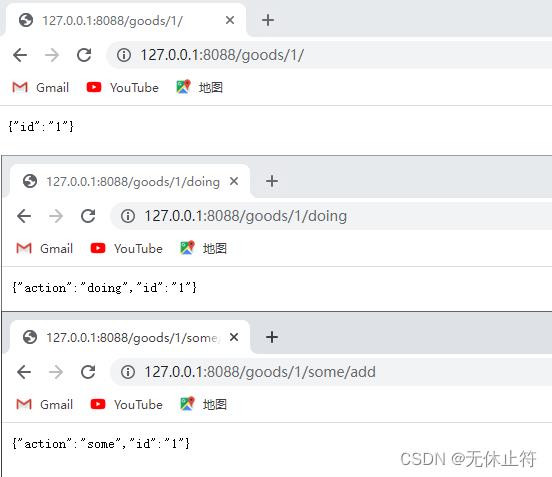
8 - required标记
- 从测试结果分析:添加了required的TAG,如果参数不是uuid返回的是404错误
package main
import (
"net/http"
"github.com/gin-gonic/gin"
)
type Person struct
ID string `uri:"id" binding:"required,uuid"`
Name string `uri:"name" binding:"required"`
func main()
router := gin.Default()
router.GET("/:name/:id", func(c *gin.Context)
var person Person
if err := c.ShouldBindUri(&person); err != nil
c.Status(404)
return
c.JSON(http.StatusOK, gin.H
"name": person.Name,
"id": person.ID,
)
)
router.Run(":8088")
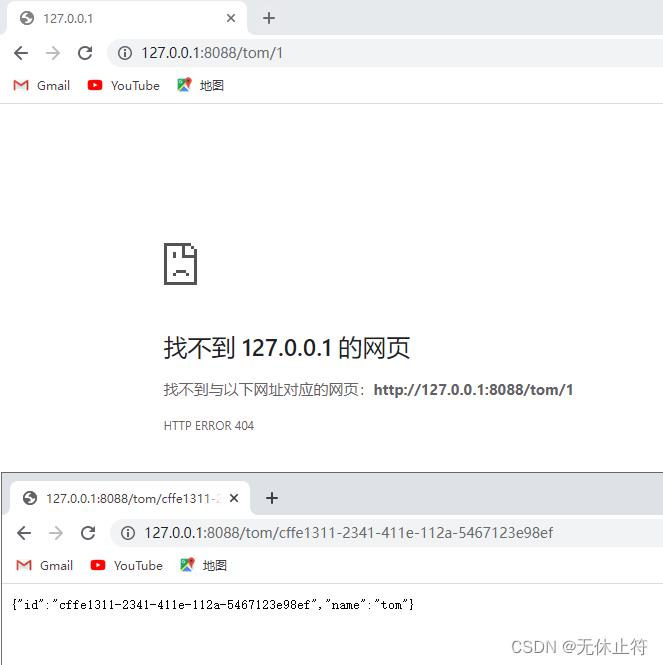
- 删除掉uuid的限制,并修改ID为int属性:ID int
uri:"id" binding:"required"
type Person struct
ID int `uri:"id" binding:"required"`
Name string `uri:"name" binding:"required"`
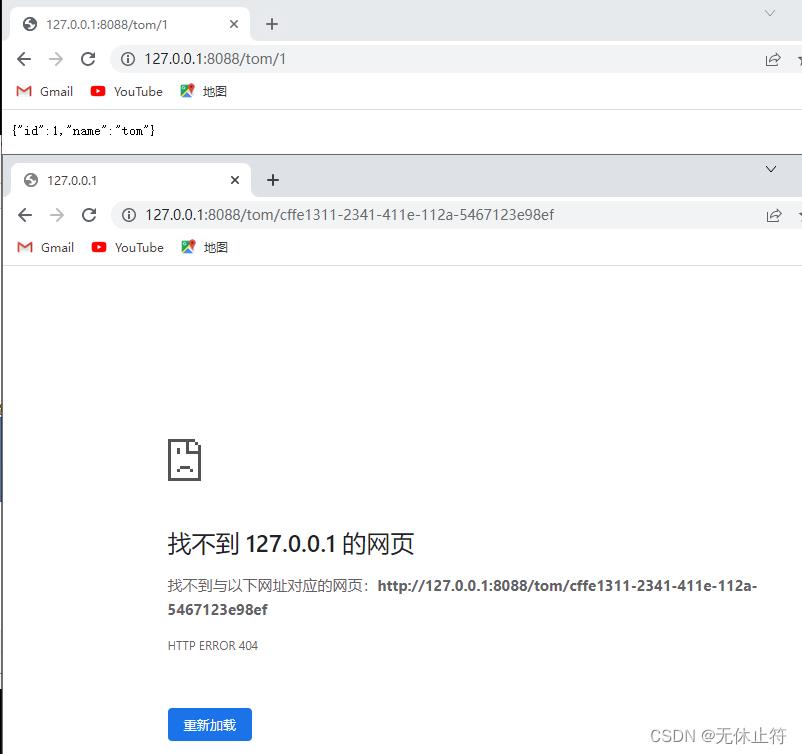
二、获取表单参数
1 - get获取参数
package main
import (
"net/http"
"github.com/gin-gonic/gin"
)
func main()
router := gin.Default()
router.GET("/welcome", welcome)
router.Run(":8088")
func welcome(c *gin.Context)
firstName := c.DefaultQuery("firstname", "zhp")
lastName := c.DefaultQuery("lastname", "test")
// 不加默认值的话就直接使用Query
//lastName := c.Query("lastname", "test")
c.JSON(http.StatusOK, gin.H
"first_name": firstName,
"last_name": lastName,
)

2- post获取参数
package main
import (
"net/http"
"github.com/gin-gonic/gin"
)
func main()
router := gin.Default()
router.POST("/form_post", formPost)
router.Run(":8088")
func formPost(c *gin.Context)
message := c.PostForm("message")
nick := c.DefaultPostForm("nick", "anonymous")
c.JSON(http.StatusOK, gin.H
"message": message,
"nick": nick,
)
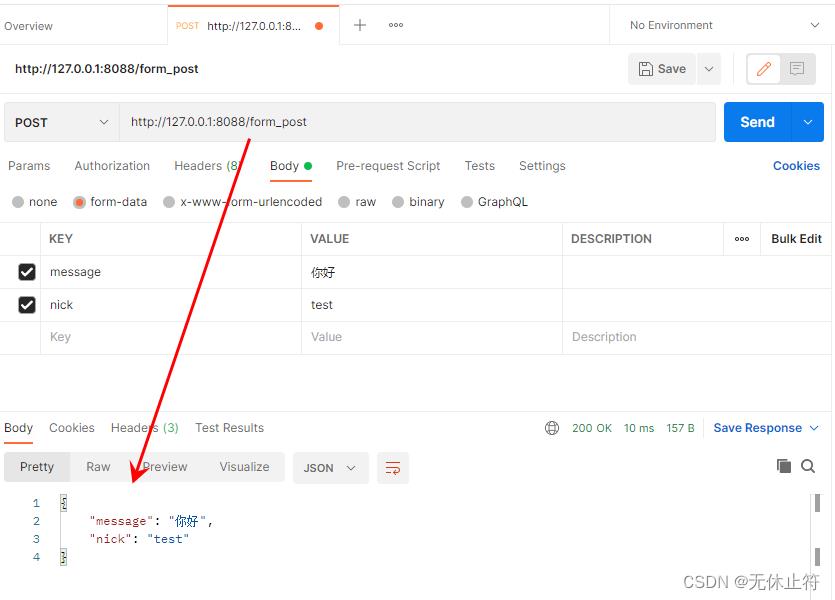
3 - get、post混合获取
package main
import (
"net/http"
"github.com/gin-gonic/gin"
)
func main()
router := gin.Default()
router.POST("/post", getPost)
router.Run(":8088")
func getPost(c *gin.Context)
id := c.Query("id")
page := c.DefaultQuery("page", "0")
name := c.PostForm("name")
message := c.DefaultPostForm("message", "信息")
c.JSON(http.StatusOK, gin.H
"id": id,
"page": page,
"name": name,
"message": message,
)


三、json与protobuf渲染
1 - json渲染
- 增加了json的TAG后:输出中就不是Name了,而是user
package main
import (
"net/http"
"github.com/gin-gonic/gin"
)
func main()
router := gin.Default()
router.GET("/moreJSON", moreJSON)
router.Run(":8088")
func moreJSON(c *gin.Context)
var msg struct
Name string `json:"user"`
Message string
Number int
msg.Name = "bobby"
msg.Message = "这是一个测试json"
msg.Number = 20
c.JSON(http.StatusOK, msg)
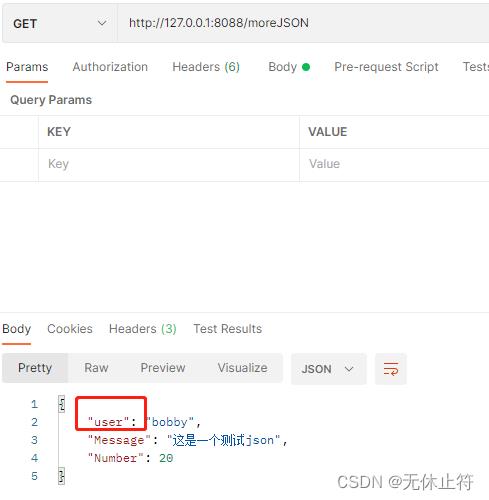
2 - protobuf渲染
- main.go
package main
import (
"net/http"
"github.com/gin-gonic/gin"
"test_project/gin_start/proto"
)
func main()
router := gin.Default()
router.GET("/someProtoBuf", returnProto)
router.Run(":8088")
func returnProto(c *gin.Context)
course := []string"python", "go", "微服务"
user := &proto.Teacher
Name: "bobby",
Course: course,
c.ProtoBuf(http.StatusOK, user)
- user.proto:
protoc --go_out=. --go_opt=paths=source_relative *.proto
syntax = "proto3";
option go_package = ".;proto";
message Teacher
string name = 1;
repeated string course = 2;

四、表单验证
1 - 登录表单验证
- gin的表单验证使用的是第三方库:github.com/go-playground/validator
- gin提供了两套方法实现表单验证:gin实际上是基于第三库的基础上进行了封装
- Must bind:如果不符合要求,就会抛出400的异常
- Method:Bind(这个仍然调用的是ShouldBind)、BindJSON。。。
- Should bind:如果不符合要求,会返回给开发人员
- Method:ShouldBind、ShouldBindJSON。。。
- Must bind:如果不符合要求,就会抛出400的异常
- 登录表单验证
package main
import (
"fmt"
"net/http"
"github.com/gin-gonic/gin"
)
// required:字段必填
// min:最小长度
// max:最大长度
type LoginForm struct
User string `form:"user" json:"user" xml:"user" binding:"required,min=3,max=10"`
Password string `form:"password" json:"password" xml:"password" binding:"required"`
func main()
router := gin.Default()
router.POST("/loginJSON", func(c *gin.Context)
var loginForm LoginForm
if err := c.ShouldBind(&loginForm); err != nil
fmt.Println(err.Error())
c.JSON(http.StatusBadRequest, gin.H
"error": err.Error(),
)
return
c.JSON(http.StatusOK, gin.H
"msg": "登录成功",
)
)
router.Run(":8088")

2 - 注册表单验证
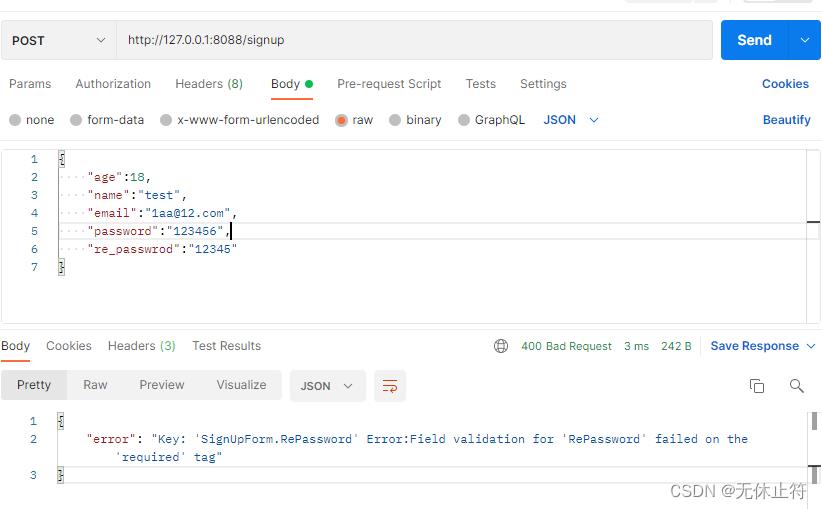
package main
import (
"fmt"
"net/http"
"github.com/gin-gonic/gin"
)
// gte:>=
// lte:<=
// eqfield:密码一致
type SignUpForm struct
Age uint8 `json:"age" binding:"gte=1,lte=130"`
Name string `json:"name" binding:"required,min=3"`
Email string `json:"email" binding:"required,email"`
Password string `json:"password" binding:"required"`
RePassword string `json:"re_password" binding:"required,eqfield=Password"` //跨字段
func main()
router := gin.Default()
router.POST("/signup", func(c *gin.Context)
var signUpFrom SignUpForm
if err := c.ShouldBind(&signUpFrom); err != nil
fmt.Println(err.Error())
c.JSON(http.StatusBadRequest, gin.H
"error": err.Error(),
)
return
c.JSON(http.StatusOK, gin.H
"msg": "注册成功",
)
)
router.Run(":8088")
3 - 表单验证错误翻译成中文
- 表单验证翻译实现:实现返回的错误是中文,并且是json格式
InitTrans:主要完成翻译的初始化,将提示的对象转换成json的小写removeTopStruct:删除掉结构体的前缀,如LoginForm.user->user
package main
import (
"fmt"
"net/http"
"reflect"
"strings"
"github.com/gin-gonic/gin"
"github.com/gin-gonic/gin/binding"
"github.com/go-playground/locales/en"
"github.com/go-playground/locales/zh"
ut "github.com/go-playground/universal-translator"
"github.com/go-playground/validator/v10"
en_translations "github.com/go-playground/validator/v10/translations/en"
zh_translations "github.com/go-playground/validator/v10/translations/zh"
)
type LoginForm struct
User string `json:"user" binding:"required,min=3,max=10"`
Password string `json:"password" binding:"required"`
var trans ut.Translator
func InitTrans(locale string) (err error)
//修改gin框架中的validator引擎属性, 实现定制
if v, ok := binding.Validator.Engine().(*validator.Validate); ok
//注册一个获取json的tag的自定义方法
v.RegisterTagNameFunc(func(fld reflect.StructField) string
name := strings.SplitN(fld.Tag.Get("json"), ",", 2)[0]
if name == "-" // json TAG如果是"-"不处理
return ""
return name
)
zhT := zh.New() //中文翻译器
enT := en.New() //英文翻译器
//第一个参数是备用的语言环境,后面的参数是应该支持的语言环境
uni := ut.New(enT, zhT, enT)
trans, ok = uni.GetTranslator(locale)
if !ok
return fmt.Errorf("uni.GetTranslator(%s)", locale)
switch locale
case "en":
en_translations.RegisterDefaultTranslations(v以上是关于10gin快速入门的主要内容,如果未能解决你的问题,请参考以下文章